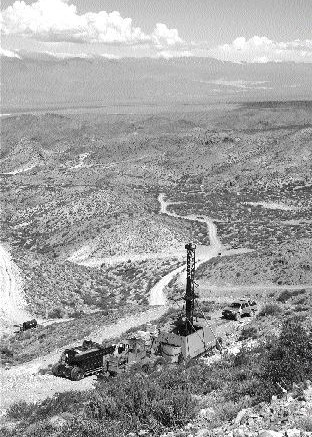Drilling by
Three holes cut the Aztec vein, resulting in grades as high as 4.2 grams gold and 1,530 grams silver per tonne over 1 metre. The two other holes cut 1-2.8 grams gold and 181-209 grams silver over widths ranging from 2.7 to 7.7 metres.
Two holes cut the Inca vein, one of which graded 2.5 grams gold and 1,100 grams silver per tonne over 3 metres, while the other returned 0.6 gram gold and 197 grams silver, also over 3 metres.
Two holes cut the B vein, one of which hit 6.5 grams gold and 25 grams silver over 1.5 metres, while the other intersected 5.6 grams gold and 39 grams silver over 3.5 metres.
Two holes failed to hit significant mineralization.
So far this year, about 1,660 metres have been drilled, primarily to test extensions of the resource in the Kamila pit. The Kamila zone has been subjected to a total of 16,600 metres (about half by previous owner Battle Mountain Gold), and the resulting data have been entered into a block model to estimate a resource.
The Kamila open pit has an indicated resource of 1.5 million tonnes grading 5.76 grams gold and 140 grams silver per tonne, equivalent to 355,700 oz. gold-equivalent. The inferred resource stands at 535,000 tonnes grading 2.3 grams gold and 69 grams silver, or 55,400 oz. gold-equivalent.
The estimates are based on a cutoff grade of 1.3 grams gold-equivalent. Gold-equivalent was estimated at 1 oz. gold for every 77 oz. silver. A gold price of US$400 per oz. and a silver price of US$6 per oz. were used, along with recovery rates of 94% for gold and 81% for silver.
Grades were capped at 40 grams gold and 500 grams silver per tonne for the Aztec vein and at 30 grams gold and 900 grams silver for the Inca vein. The B vein was capped at 35 grams gold and 500 grams silver per tonne.
The Aztec vein has an average true width of 8 metres; the Inca and B veins each average 5 metres. About 85% of the proposed open-pit resource, and almost 73% of the defined tonnage, is in the indicated category.
A resource estimate of the high-grade zones in the Kamila pit was calculated using a cutoff of 1.3 grams gold-equivalent and by capping gold values at 110 grams per tonne and silver values at 1,700 grams. The indicated resource totalled 226,000 tonnes grading 19.2 grams gold and 432 grams silver per tonne, or 180,400 oz. gold-equivalent.
Speaking at the annual convention of the Prospectors & Developers Association of Canada, held recently in Toronto, Intrepid Minerals President Laurence Curtis, remarked that the Kamila zone is contained in a 600-metre-area and that “sometimes small is significant.”
“There are not many deposits in Latin America that are open-pittable and carry this grade,” Curtis said. “At this time next year, we expect to be well on our way to the Kamila feasibility.”
During the next few months, drilling will continue and reconnaissance targets will be tested. Other vein systems have been found on surface, one of which may change the outline of the proposed Kamila pit.
Kamila is within an east-southeast-trending deformation zone, which extends over at least 3.5 km and has a width of 500 metres.
Intrepid holds 19 properties within 50 km of the Casposo property, and these cover 800 sq. km. Casposo is 20 km from the mining community of Calingasta.
The company is also working on the San Cristobal project in El Salvador and, in conjunction with


Be the first to comment on "Intrepid firms up Kamila resource (March 21, 2005)"